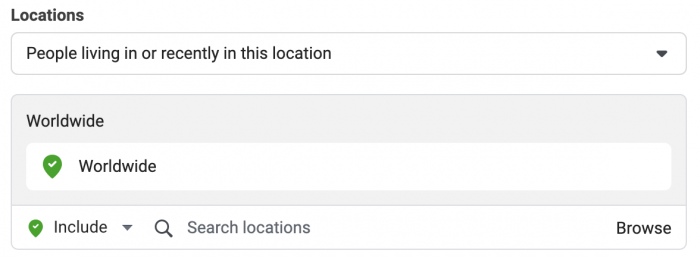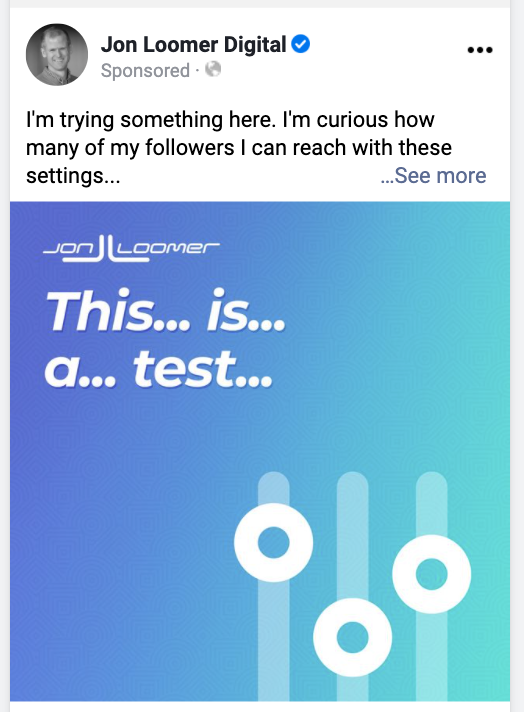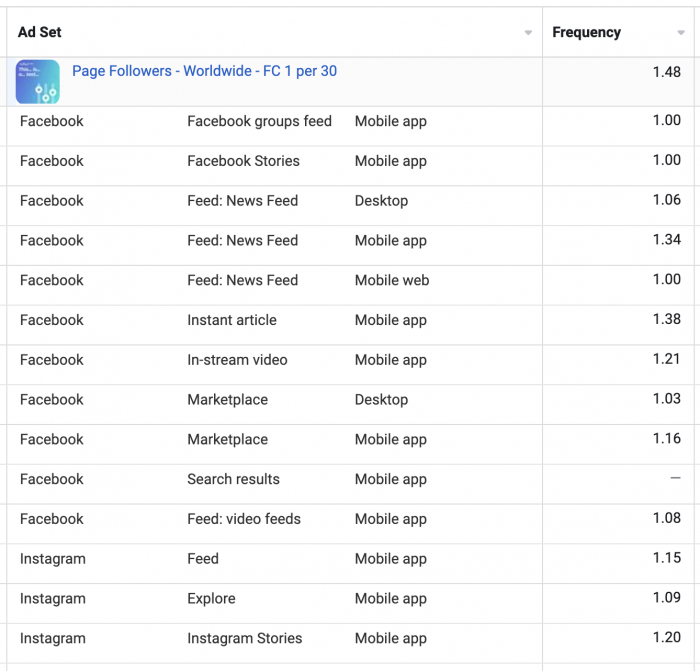I first wrote about my somewhat insane experiment a couple of months ago. The goal was to reach all of my Facebook followers with a single ad. This experiment is now complete, and I’m ready to share the results.
In this post, I’ll recap a bit from the first post, and then we’ll get to what happened by the end.
Ready? Let’s go…
The Inspiration
So, why was I doing this in the first place?
Well, it all started with a frustrating conversation about organic reach (seriously, is this 2013?). An advertiser was talking about how he runs ads to his clients’ followers trying to reach them all. He does this because he’s so mad that there is no organic reach now (not totally true, but I digress).
To me, this approach was likely to be incredibly expensive and counterproductive. But, it got me thinking…
Could I create an ad that reached all or most of my Facebook page followers? How would I do it? How many would I reach? How long would it take? How much would it cost? Would it be worth it?
I saw this as a challenge. On November 6, I created the campaign.
The Setup
Okay, so we want to do everything we can to reach all of my followers with a single ad. The best way to do that, of course, is with a Reach campaign. If you’ve been around my stuff long enough, you’ll know this isn’t my first experiment with Reach optimization.
I would want to target all of my followers. To do that, I used a custom audience (this changed during the past year or so from targeting by connection).

And since I want to target all of my followers, the country doesn’t matter.

I initially used all placements, but that would eventually change (more on that later). Since this was a Reach campaign, I could use a frequency cap. I went with 1 impression in 90 days.

In other words, I expected this campaign to end within 90 days. But I wanted to limit waste. I really didn’t care whether you saw my ad, only that I reached everyone once.
To do this, I went with a “robust” $10 per day budget. Looking back, I probably could have nudged that up a bit. But, who knows if that would have negatively impacted CPMs. It was a slow drip.
I used a very simple image ad that explained what it was that I was doing.

What I Expected to Happen
Recall that I used Reach with a frequency cap of 1 impression per 90 days. I assumed that Facebook would focus on the people who were the cheapest to reach first. So, I didn’t expect to really reach anyone within the United States, United Kingdom, Canada, or Australia early on. I expected frequency capping to eventually force Facebook to show ads to people in the more expensive countries.
In theory, I’d get a ton of reach in the early going, and then the daily reach would slowly shrink over time. Of course, this also assumed that frequency capping would work as it should (foreshadowing).
I did believe that I’d get close to reaching everyone. Though, it made sense that I’d never reach some. My page has been around for over a decade, so some of my followers are inactive or rarely visit Facebook. Some may just never get the ad due to bad timing when they are on Facebook.
One thing that was uncertain was what “everyone” meant. My total follower count is close to 196,000 people. But, for some reason, Facebook projects the custom audience to be between 133,400 – 157,000 people (this range may actually be important later).
I have page followers from everywhere around the world. Lots of reasons for where my various followers are from. Certainly, I tried some bad strategies with ads in the early going before we all knew what we were doing. That’s not even an excuse or apology. I think it’s pretty cool that my followers are from everywhere.
Ultimately, about 62,000 (32%) of my total audience should be from the United States, United Kingdom, Canada, and Australia. I mention that because I assume these people will be most difficult to reach. Or, at least, they will be the lowest priority in the system due to cost. So, I figured that these people would be those I was least likely to reach.
That’s what I expected. So…
What Happened?
Everything went as expected early on. It was super cheap to reach people on the first day of this experiment. The ad reached more than 17,000 people with a CPM of $.56 on that first day (even reached four people from the UK and two from Australia that day).
The CPM increased on most days from that point forward during the first month or so. By November 10, the percentage of my daily reach to the Big 4 (US, UK, Canada, Australia) had increased to 10%. That percentage was over 20% by Nov. 14, 30% by Nov. 16, and 40% by Nov. 20. It would then stay in the 40s and 50s for most of the rest of the experiment.
The CPM (Cost Per 1,000 Impressions) would rise from $.56 on Nov. 6 to $5.44 on Nov. 24. I’d reach 100,00 of my followers in the first 30 days for $300, which created some nice, round numbers for a great blog headline ($300 Spent to Reach 100,000 Facebook Followers in 30 Days).
This ad had reached more than half of my audience in only 30 days — and I still had 60 days left. It seemed like I was destined to make it!
The CPM eventually reached $10 on Dec. 21. This, of course, was also a very competitive time due to the holidays. CPMs would drop briefly below $10 again on January 1-2, but they’d then stay above $10 for most of the rest of this test. The highest it would get was $17.37 on Jan. 16. You can imagine daily reach was crawling at that point.
While it would initially look like I had a shot to reach everyone, the campaign would eventually stall. I’d reach a total of 138,292 people, far shy of 196,000.
But, wait… Remember when Facebook said the custom audience includes between 133,400 and 157,000 people? Well, I did reach that range! I’m curious to know why that range is so much lower. But, this does make it possible that I reached everyone I was capable of reaching — or close to it.
Weird Stuff: Frequency Capping
A bunch of stuff got weird along the way. What’s great about this experiment is that I’d probably only notice the weird stuff because of the experiment. And it helped me discover some things.
First, I started getting comments from people who knew what I was trying to do. They’d tell me they saw my ad multiple times. It’s always tough to know whether they actually did see it multiple times or if they were seeing it organically. But this was repeated enough to know it was an issue.
I would eventually use Breakdown by Placement and see that some placements were certainly not being restricted by the frequency cap.

I should note that the results above are after this experiment completed. It actually got worse at the end (more on that in a minute).
Why was this happening? Well, it made me realize there is a weird message from Facebook when setting up a frequency cap:

As part of our efforts to regularly update our systems and processes, we’ve made changes that may result in some people temporarily seeing your ad more times than the maximum frequency you set.
This seems recent. But, the frequency was definitely not capped at one impression in 90 days, even if it was mostly close. The total frequency would be 1.48, though a huge part of that increase was during the final week.
I know… Does it really matter? Frequency is still under 2.0. So who cares, right?
But, sometimes you might not want to reach people multiple times. And when you set a frequency cap, you expect Facebook to — at least mostly — follow it. What’s annoying about this is that close to 70,000 of the 205,000 impressions weren’t what I wanted. It’s wasted money.
Weird Stuff: The Final Week
Back to what happened at the end. The total frequency was only 1.16 through January 22 (it would end on February 3). At some point, Facebook prematurely ended the 90-day cap and started over again. What happened next? You probably won’t be shocked.
The CPM dropped to about $1 on Jan 28 and stayed between $1-3 through the end of this experiment. I started reaching people in the US, UK, Canada, and Australia a lot less again. But, it gets better…
The total accumulated Reach actually DROPPED! Let me explain…
During January, the total accumulated Reach typically increased by 3-400 people per day (remember that the cap wasn’t perfect). But, all of a sudden, the total accumulated Reach actually DROPPED by six from Jan 28-29 and by four more from Jan 29-30.
Look, here’s the total Reach through January 28 (138,246).

And here’s the total Reach through January 29 (138,240), after it ran for another day.

What kind of crazy sense does that make? Well, I have a theory.
The frequency cap is clearly starting over, so no new people are being reached (or very few are). This would magnify the impact of Facebook removing any accounts, resulting in drops. So, let’s say that this ad reached 5,000 total people on that day, but only five were new. Meanwhile, Facebook removed 11 accounts that I had previously reached.
That’s my theory, at least. These drops, otherwise, defy explanation.
What I Learned
So, I couldn’t reach all of my followers after all, at least not the way I did it. I did learn a few lessons along the way.
1. Frequency capping is very imperfect!
This is something that is hard to see without running an experiment like this one. Facebook does not keep to the strict cap that you set — consider it more of a “soft” cap.
There are apparently limits to the number of days you can use with frequency capping, too. I don’t know how else to explain what happened during the final week when the cap seemed to start over before 90 days expired.
It also appears that certain placements may be more prone to these lapses in cap enforcement. I didn’t see anything consistent here, though, but I have my suspicions about certain placements.
2. I would have set a higher daily budget if I were to do this again.
Maybe $20? While $10 was sufficient during the first 30 days, the higher CPMs and Facebook’s failure to enforce a strict cap resulted in reaching a pretty small group during the final month.
While a higher budget may lead to reaching more people, I’m curious what this would do to CPMs. Would I ultimately reach even fewer people?
3. How could I apply this elsewhere?
This is the most important lesson. It’s what ultimately inspired my “Sprinkling” strategy. Essentially, that’s what this experiment was, on a very controlled scale.
I showed a lot of people an ad. Some saw it, some didn’t notice it. There wasn’t a sense of urgency. What if I did that with opt-ins? Promotion of my Power Hitters Club membership? Blog posts?
We’d need to tighten the cap a bit, and probably tighten the audience size, too. But, consider a 30-day campaign that includes 100,000 people, using a frequency cap of 1 impression per 30 days and promoting an evergreen product or opt-in.
You may see it once. If you sign up, you won’t see it again. If you don’t sign up, you may see it again next month.
This is a much softer, less urgent, and more evergreen approach to promotion. It’s much more in line with email drip campaigns.
Conclusion
I’m really glad I did this. It was such a silly premise at first, but I learned a lot from it, and I’ve already been applying it in other places. And hell, it was pretty freaking fun, too.
I hope that Facebook tightens up the frequency capping because that would really help make this more effective going forward. The message from Facebook about this seemed to be based on the current environment, so I don’t think it’s always been the case.
Ultimately, this test is just an example of something I encourage you to do often: Experiment. Try new things. See a problem and put together a plan for how to solve it. Use tools available to you in creative ways that maybe weren’t created for that purpose.
Have fun with it, learn from it, and apply what you learn!
Your Turn
I hope you enjoyed this journey and maybe took something from it. Have you ever done anything like this before?
Let me know in the comments below!






